Three days. Hundreds of memories.
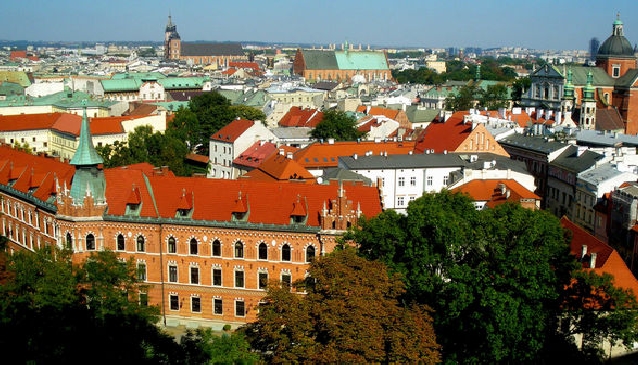
Boarding my flight to Poland’s former royal capital I cracked. Despite a somewhat time-induced resolution of absence up until this point, once strategically positioned between one side of the planes plastic inner-shell and my fellow passengers, a fervent flick through my pocket guide ensued.
My appetite had been tickled, however, my mind was yet to be clouded with preconception - something I was very keen to avoid as I had a feeling the next three days would stir up all kinds of discoveries. Least of all, the realisation that this is a city whose essence ignites once you begin painting the attractions in Krakow by numbers...
40, 000 square metres
Krakow’s main market square stands today as the largest main market square in Europe at 40,000 square metres. It dates back to 1257 and is the focal point of a stay in the old town. The centre point is marked by the Sukiennice, or Cloth Hall, and is a place where people come to shop, visit the Underground Museum or sit back with a coffee and watch the world go by. Go by it has, as the level of Krakow’s streets has risen considerably over the years. This has given rise to many café’s, restaurants and bars situating themselves underground in the basement of premises in the old town. Atmospheric and full of character these basement bars are worth seeking out – and if it’s hard to find, it probably means the effort is worth it.
Aside from shopping, sipping and circumnavigating, the main square also offers ample opportunity for swatting up on your history, starting with St Mary’s Basilica. This impressive church on the main squares eastern side, is striking not only in its stature but equally in the legend that surrounds it… It is said that two brothers built the towers that form its front façade and as one brother’s tower grew taller than the other, jealousy spun him into a rage and he killed his over-achieving sibling with a knife. With his brother removed from the equation he continued to construct his tower… inevitably making it taller than the one remaining. However, guilt eventually caught up with him and he threw himself off the tower once complete.
Another tale centres on the heroics of a trumpeter who based himself in the church tower during the 13th century Tatar invasion. The trumpeter stood watch over the city and signalled the open and close of the city gates as well as sounding the alarm from invaders. On one occasion the Tatars were spied in the distance and the trumpeter raised the alarm, only to have his tune cut short as an arrow pierced his throat. Today, on the hour, a bugle player comes to the watchtower window and plays to the four courners of the world… cutting short his melody at that same point, in memory of the guardsman. Indeed, you don’t have to be in Krakow to hear the bugle player’s song, as the 1st Polish Radio Programme broadcasts it live at midday. This is a tradition dating back to 1927 and only briefly halted during the Nazi occupation in WWII before re-commencing in 1941.
A good way to learn all the history this iconic square has to offer is by joining a tour. I opted for a DIY guide with an iPod…
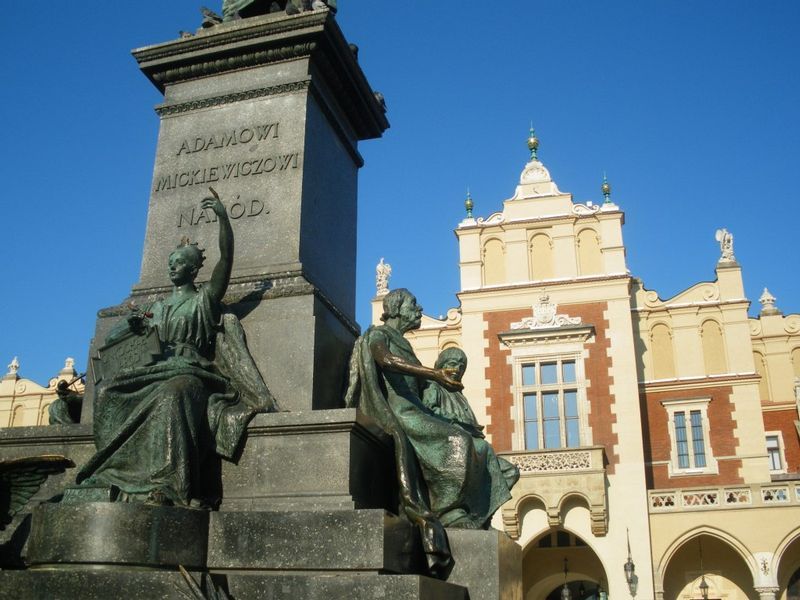
Karakow's Main Market Square
120
Krakow is a city of many things and churches are certainly one of them. In fact I’d even go so far as to say the sheer enormity of places to worship in, rather creeps up on you as you amble through the streets. Walking the old Town you’ll encounter no fewer than 60 stone structures with their own unique history and stories to tell. The best plan for those wanting to take in those in the old town is to venture out on foot, stopping to refuel in one of the many cafes along the way. If time is of the essence however, here are my top three you have to fit in (aside from St Mary’s Basilica of course…)
Wawel Cathedral: This impressive gothic structure is well worth some of your time in the city and you’ll be sufficiently rewarded for your investment. Admission to the main Wawel Cathedral building is free however; it is well worth paying for the audio guide as there is so much to take in. Both the bell tower and crypt are well worth visiting. The first involves a rather adventurous climb up to the resting place of one of Poland’s iconic symbols, Sigismund Bell. As the largest bell in Poland it is so substantial that it takes 12 people to ring it. Legend has it that should you touch your right hand to your heart and left hand to the bell, any wish you make will come true... There are some great views from up the top. The latter, is home to most of Poland’s great kings and historic figures as well as President Lech Kaczynski, who tragically died in a plane crash in 2010.
St Francis’ Basilica: For those into their stained-glass you should definitely head to St Francis’ Basilica where you can indulge in some impressive Art-Nouveau creations. While not immediately attention-grabbing from the outside it’s once you get inside this 13th century structure that your eyes are greeted with some truly unique works of art. The swirling ‘Act of Creation’, the handy-work of artist Stanislaw Wyspianski in 1900 is perhaps the most striking and sits at the rear of the building.
SS Peter & Paul’s Church: As well as being the location our local expert tied the knot; it’s also one of the finest and most memorable baroque churches you’ll lay eyes on, as well as Krakow’s oldest. Distinguishable by the statues of the twelve apostles posing in stone at the edifices exterior, this façade was completed in 1619 and appears to have exhausted the construction budget, being as it is, the rest of the building’s exterior is made out of brick.
2
Waiting outside the Atelier Aparthotel (my abode for the three nights in the city), with my belly full from a hearty breakfast and my head well rested from a sound night’s sleep I was slightly unsure as to how exactly the following three hours was about to pan out. The emergence of a battered East German Trabant from around the courner soon set the mood however, and ensured this ‘crazy communist tour’ was not an experience easily forgotten (not least because it was a car clearly not designed for tall people...)
Nowa Huta lies 7km from Krakow’s centre (and is accessible by tram should you want to head down independently) and was built as a communist district under Stalin. Nowa Huta translates as ‘New Steelworks’ and this enormous steelworks dominated the district, employing in its heyday just shy of 40,000 workers. The crazy communist tour takes you on a journey through the streets, designed as they are in 5 grids to represent the red communist star. Each tour comes complete with a driver, and thus guide, who takes you through the rise and fall of this now UNESCO protected district. 300,000 people once called Nowa Huta home, now it’s more like 100,000 though the buildings remain largely the same. Hearing how our guide still remembered not being able to find oranges in the supermarket, how drivers were paid more than doctors and how even drinks in the cinema were rationed to one per person is an eye opening experience.
The people’s struggle also makes for a concentrated listen as ‘Kor’ (the civil movement formed around 200 miles from Krakow) started to rock the landscape. ‘Solidarity’ was however, behind the ‘wind of change’ and subsequent communist revolution in the country and proved to be an inspiration for other Eastern Block countries to change their system. Started in Warsaw, ‘Kor’ proved an important precursor to ‘Solidarity’ and you can check out the project ‘HardKor’ in Nowa Huta’s old cinema for more revelations...
Please note: The assistance we provided in starting the Trabant, while both highly necessary and amusing is not a guaranteed part of the tour experience. Nor, I’m told is the 80’s Polish dance/electro beats pumping through the speakers upon your return… though I’m sure if you ask your guide nicely….
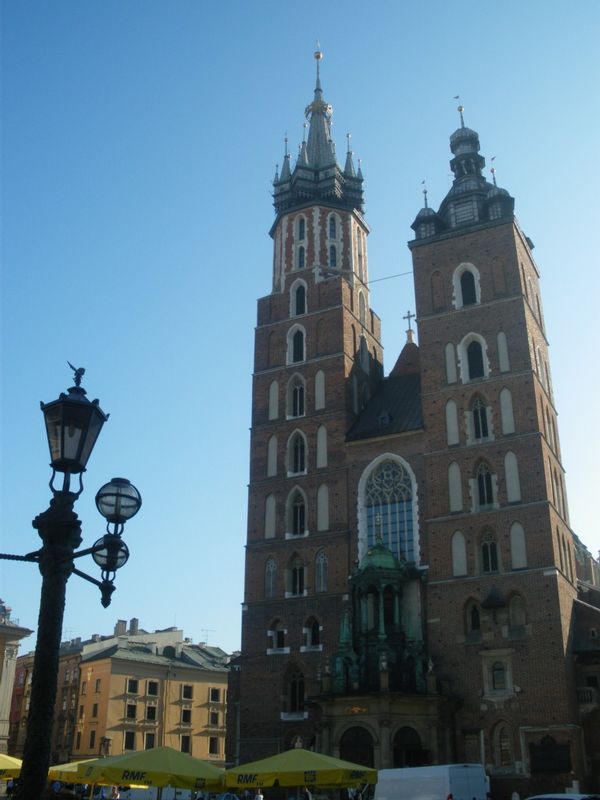
Churches
1.5 million
As you pass through the gate at Auschwitz embezzled with the Nazi slogan ‘Work Makes Free’ it’s clear how sufferable this ex-army barrack would have been. Nowhere is out of view from a watchtower, barbed-wire encircles the perimeters and the cold, uniform buildings provide little comfort from the outdoors. This is all on a bright and pleasant Saturday morning in October, 2011…
40, 000 pairs of shoes, 2 tonnes of human hair and piles upon piles of suitcases, spectacles, shaving brushes, combs and crockery can all be viewed as you pass from building to building, highlighting like no other the extent of human loss. Block 11 (the block of death where prisoners were routinely tortured), Block 10 (known to be where Dr Josef Mengele carried out his horrific human medical experiments) and the wall of death (where prisoners were routinely executed) are only superseded in brutality when the tour takes you to the camps gas chamber.
The horror of what went on in Auschwitz and Birkenau (known as Auschwitz II) is truly hard to comprehend. Between 1940 and 1945, 1.5 million people lost their life at the hands of the Nazi’s in these harrowing death camps. Birkenau, the largest of the camps in occupied Europe at 175 hectors, contained barracks which held up to 900 prisoners at a time as well as 4 gas chambers where thousands of innocent lives were lost to the lethal Zyklon B.
Birkenau lies 3km from Auschwitz and the sheer scale of this camp of horror can be seen by climbing the watchtower at the entrance. One scarcely dare imagine the scene as hundreds of Jews and political figures from all over Europe were herded here in cramp train carriages and their fate sealed in a single glance by a Nazi doctor: seemingly healthy and you would be sent to the barracks; elderly, ill, frail or a child and you would be gassed. If you survived this, you faced starvation, exhaustion, torture and medical experimentation.
Words cannot do justice to the sheer range of emotions that will wash over you as you journey through the reality of life for so many innocent lives. Indeed, even upon liberation on the 27th of January 1945 those who left were traumatised forever...
378
Wieliczka Salt Mine is one of Krakow’s iconic tourist attractions and lies 15km southeast of Krakow, reaching a maximum depth of 1, 073 feet. For those of you who have been in a colliery before, please note, this is no ordinary mine…
For a start it is carved entirely out of salt*. Secondly it covers 7 million cubic metres. Yes, 7 million cubic metres…. Not that you’ll get to see it all mind. I was underground for around three hours, walking from start to finish and my guide pointed out that in around 2 miles of tunnels we’d taken in about one percent of it. This one percent is however, fascinating. You start by descending the 378 steps to level three where the tour begins. The winding passageways take you from chamber to chamber where you pass salt-carved statues, and scenes depicting the mining that once went on here. The pièce de résistance, is, The Chapel of the Blessed St Kinga, at 101 metres below ground and carved entirely by salt – yes, even the chandeliers. Weddings and services take place here and John Paul II even visited in 1971 - seven years before he became Pope.
As well as being an impressive 700 years old, a protected UNESCO World Heritage Site and location for the world’s first underground balloon flight the salt mine’s many statues and chapels are an inspiring lesson in what can be achieved in one’s time off…
*You are welcome, no, encouraged to test this… just abstain from selecting a statue upon which to lay your tongue…
9
I’m guessing I’m not alone in believing that a big part of any visit overseas lies in the food you’re gearing yourself up to indulge in as soon as the guilt-free ticket to sample all you desire in the name of research comes into play… (that would be as soon as you’ve left the airport then…)
Here are my top picks:
1. Zurek
Soup to the Polish is akin to baguettes and the French… Both are likely candidates in a ‘guess- the-dinner-menu-ingredient’ in their respective homelands and both hold strong for reasons understood the moment they pass the lips. A hearty combination of rye flour, hard-boiled egg, potato and Polish sausage, Zurek is a soup enjoyed as a starter in many Polish homes. Dunk some baguette in and I’d say you’re onto a winner…. : )
2. Pierogi
For those who are partial to ravioli, the Polish twist to this Italian gem will have the taste buds tingling. A cross between a pasta and dumpling these little pockets of joy are stuffed with vegetables or fruits – depending on your desire to indulge as a starter, main or desert… dare you to go for the hat trick….
3. Oscypek
Cheese fiends had better book their ticket to Poland now. This hard, smoked, salty slice of cheesy cheekiness comes spherically shaped and carved like a nugget of gold. Order it in restaurants with cranberry sauce or seek out a local producer (the mountain region is ideal for this) where your initiative will be dutifully rewarded…
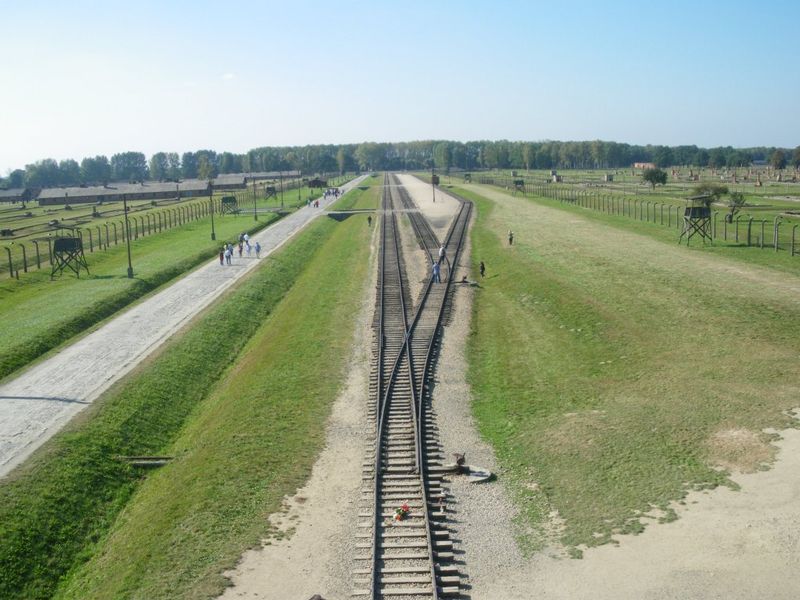
Krakow
2.5
Paragliding is one of those things that just has to be done at least once in your life and fortunately on my second day in Poland, my time had come… After an hour’s drive from Krakow’s city centre I found the landscape opening out to fields, mountains and a calm that appeared perfect for my pending flight. I was however, in for a wait... The breeze that had filled me with such glee as we exited the car now threatened to scarper my plans as it is not, as it turns out, good to have anything more than the resultant squall of a hand dryer on its last legs for gliding above the earth’s crust attached only to a large polyester sail… hmmm.
Needless, to say the wait was vehemently worth it… in fact I’d go as far to say that I’d inadvertently found the optimum flight time – sunset. For the chance to check out my flight (running man impression included) I have a video. For the rest of you please move onto 1978…
1978
For a city so underpinned in places to worship, it perhaps comes as little surprise that Krakow’s catholic roots lie in much more than stone and mortar. Polish bishop, Cardinal Karol Wojtyla, succeeded Pope John Paul I after a two-thirds majority vote in 1978 after the former died after only 33 days in office. This dramatic change of events thus transformed Cardinal Karol Wojtyla into John Paul II… and the first non-Italian Pope in over 400 years.
Today you can see the iconic balcony in Krakow’s old town where John Paul II would come, as Pope, to hold ‘night talks’ with his friends and locals whom he’d life behind when moving to the Vatican. People flocked here to enjoy his talks and sock up his charisma, personality and spiritual leadership. His student days as an actor certainly helped draw people in and at a time where hope was important, along with KOR and Lech Walesa (co-founder of ‘Solidarity’, Nobel Peace Prize winner and President of Poland from 1990 to 1995), John Paul II was hugely influential to people’s lives – believers and non-believers alike.
The Bishop’s Palace lies opposite Franciscan Church and displays the Popes image above where he stood and spoke. For those wanting more insight into the Pope’s previous life you can step inside Collegium Maius, the oldest building of the Jagiellonian University, and of which John Paul II is a graduate.
426
Though, I’m sure you’ll be pleased to note that I’ve carefully handpicked only a selection for your viewing pleasure in this article…
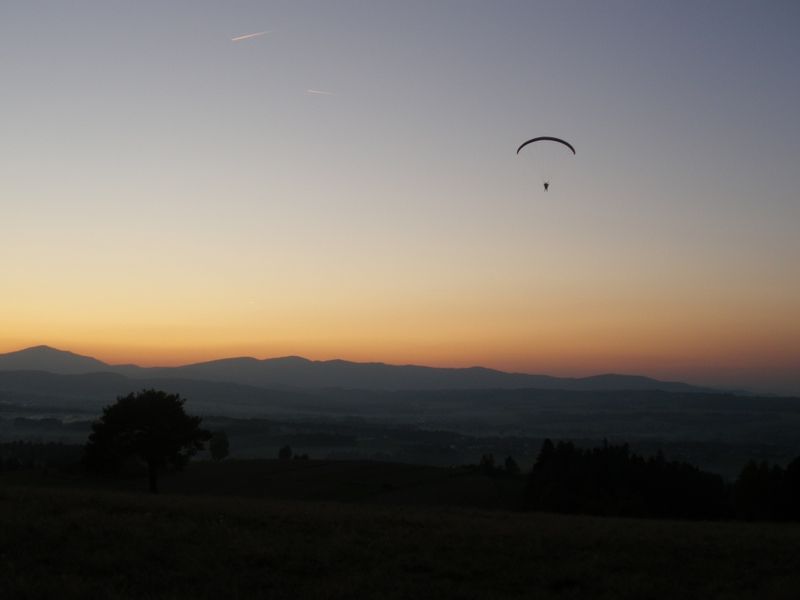
Paragliding